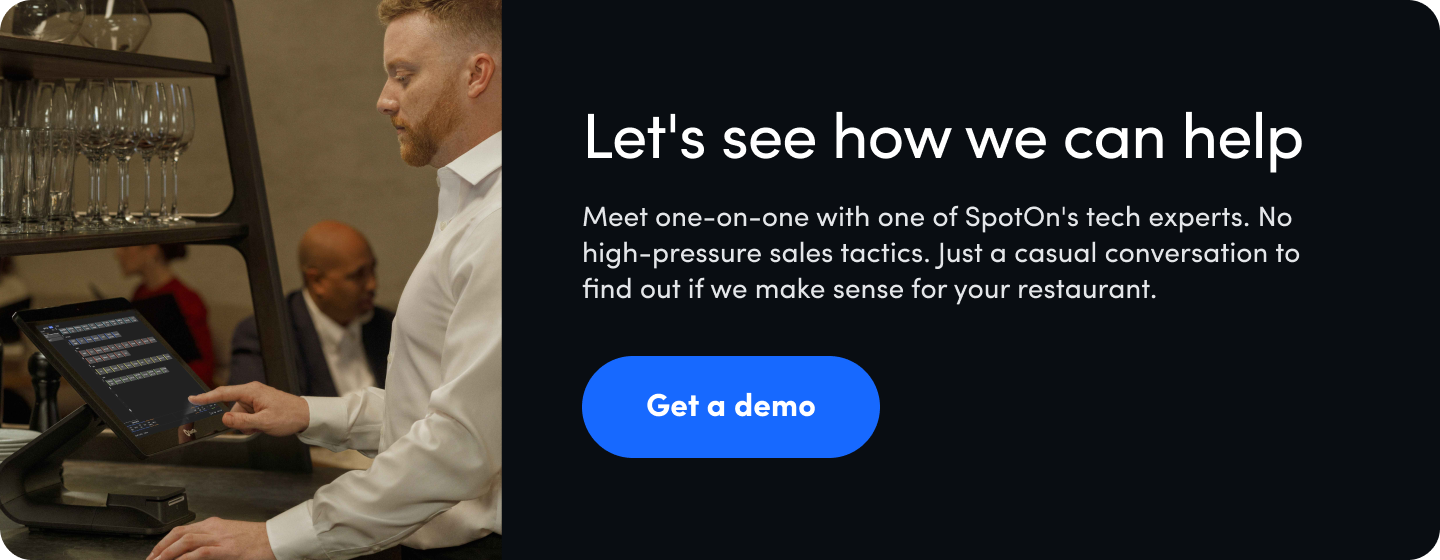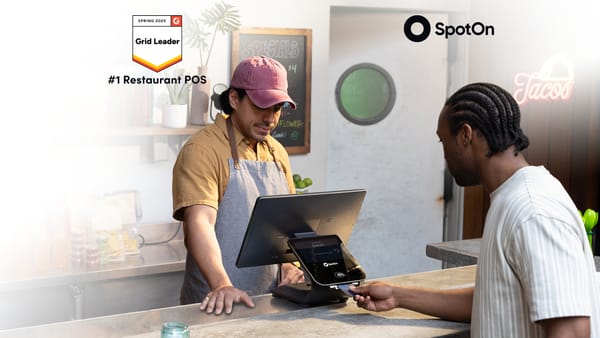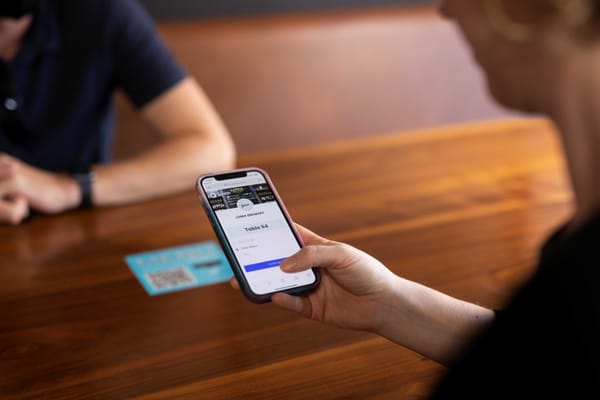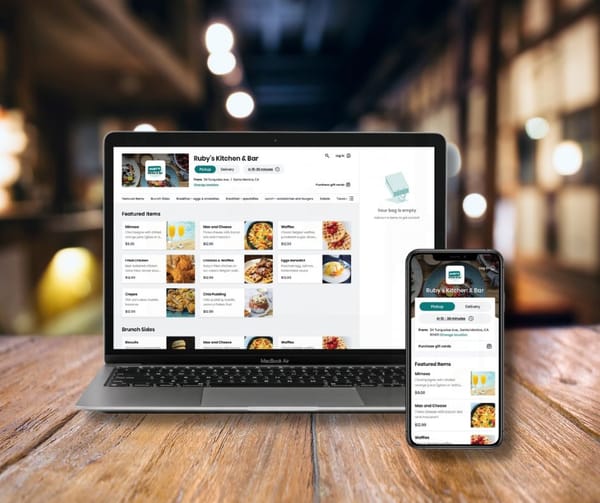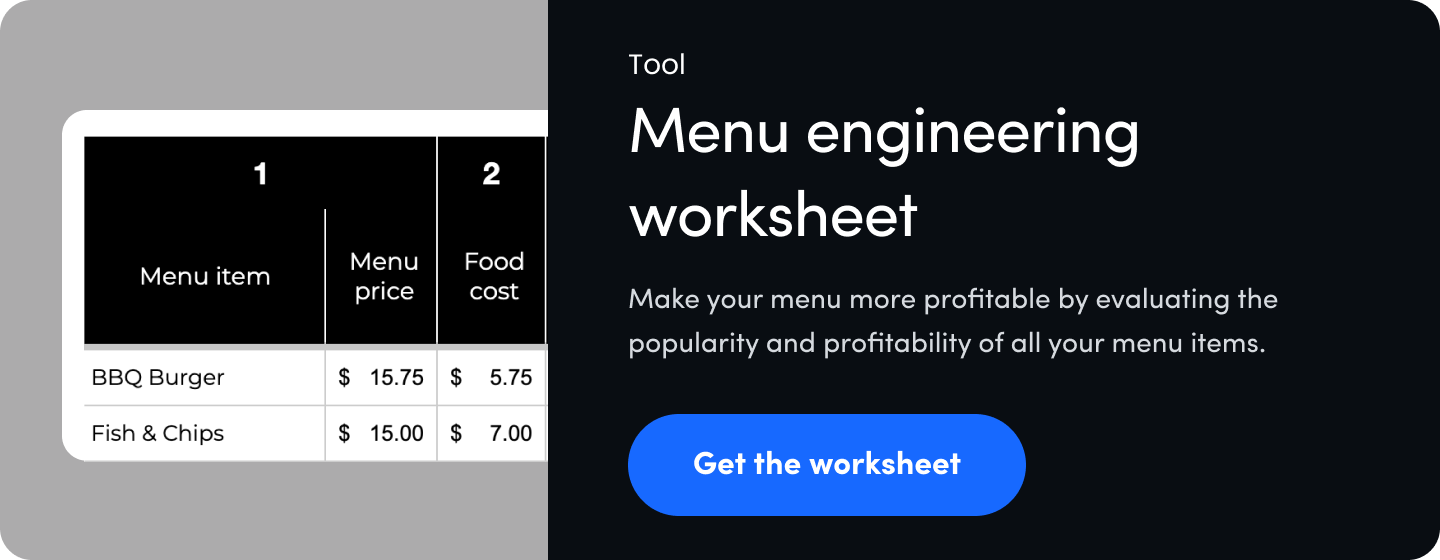
According to a Gallup poll, guests only look at your menu for 109 seconds before ordering. Menu engineering uses real data to show you which items are the most profitable and should be your main focus. It also reveals which ones are dragging you down and need to be removed. See how your menu items are performing with our free menu engineering worksheet.
- The menu engineering worksheet explained
- What is menu engineering?
- How to calculate gross profit margin
- What to do with your menu engineering results
- How to design your menu for profit
The menu engineering worksheet explained
Our worksheet simplifies your menu engineering efforts. And it's free. To get started, you just need a little bit of information.
Menu item name & price
Open your menu and add items and their prices from a section. For the best results, only put in similar menu items. Like entrees, beverages, sides, or appetizers. That way you're comparing apples with apples.
Menu item cost
Ask your chef or kitchen manager for the cost of each item. This is also called your recipe cost. Ideally, you should be tracking these with inventory management software. But if you just need a quick calculation, here's how to do it.
- List the ingredients and measurements of a menu item
- Divide each ingredient package cost by the number of measurements in the package to get each ingredient cost
- Add up the ingredient costs to get the menu item cost (recipe cost)
Before we were doing our inventory by hand. With an integration between my POS and inventory management software, we were able to cut down at least 20 hours a week on inventory alone.
–Johnny, Tinys & The Bar Upstairs
Number of items sold
To determine the popularity of menu items, we have to look at your product mix or PMIX—a report that shows sales data for each item over a set period. This should be in your POS reporting. Typically, a restaurant owner will look at the PMIX for a month. But if you have data for a quarter or year, that's even better.
Popularity & profitability targets
These are your targets for your sales (popularity) and gross profit margins (profitability). For popularity, look at your top 3 to 5 selling items and set your target just under these numbers.
For profitability, a good gross profit margin is around 70% on average. But this can vary. Full-service restaurants may shoot for higher gross profit margins since part of the cost of service must be paid for through prices. On the flip side, counter-service concepts might aim for a lower gross profit margin because of fewer employees.
See how restaurant veteran Scott Youkilis helped Kappy's make its menu more profitable.
What is menu engineering?
Menu engineering analyzes your menu performance using each item's popularity and profitability data. For popularity, we look at how many of each item were sold over a period of time. For profitability, we find an item's gross profit margin. With these two numbers, your menu items can be plotted on a graph, also known as a menu engineering matrix.
After that, the menu engineering matrix is divided into four quadrants—stars, plow horses, puzzles, and dogs. Where exactly these quadrants lie on the matrix is dependent on your sales and gross profit margin targets. As each menu item is plotted in the matrix, you can see how it's performing in popularity and profitability compared to the rest of your menu.
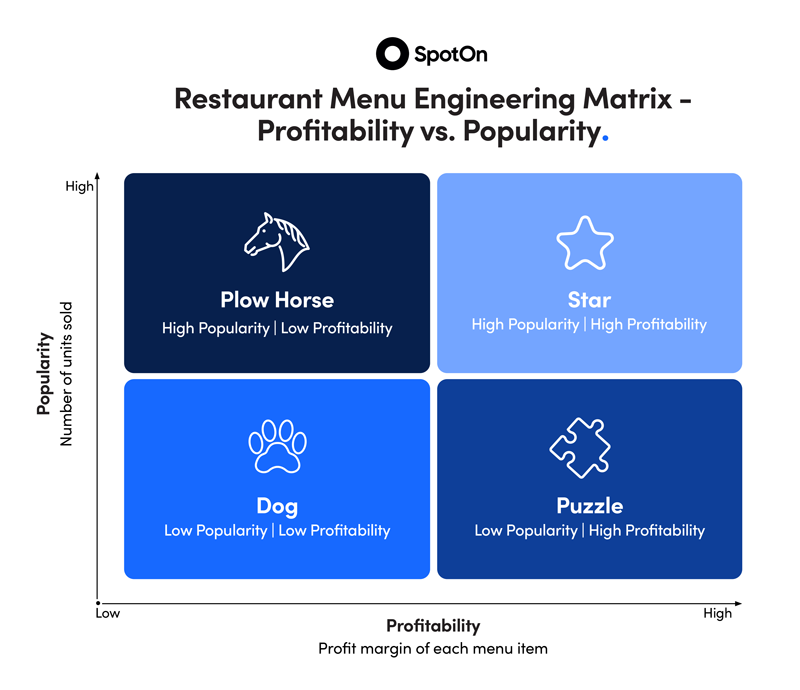
How to calculate gross profit margin
The gross profit margin of an item compares its price to its cost. This is expressed as a percentage. When you enter your data, our restaurant menu worksheet automatically calculates your gross profit margin. But if you want to do it by hand, here's how.
Subtract the item cost from the item price to find that item's gross profit. Then divide the gross profit by the item price and multiply by 100 to get the item's gross profit margin. From here, you can calculate its food cost percentage by subtracting the gross profit margin from 100. Here are the formulas.
Ex: 15.50 - 5.75 = 9.75
Ex: 9.75 ÷ 15.50 x 100 = 63%
Ex: 100 - 63 = 37%
What to do with your menu engineering results
When you enter your data, the menu engineering worksheet automatically categorizes your items as stars, plow horses, puzzles, or dogs.
- Stars are your best-selling and most profitable items.
- Plow Horses sell well but aren't meeting your profit goals.
- Puzzles are designed for profit, but aren't meeting your sales goals.
- Dogs aren't reaching any of your targets.
Let's look at some menu engineering tricks for each category.
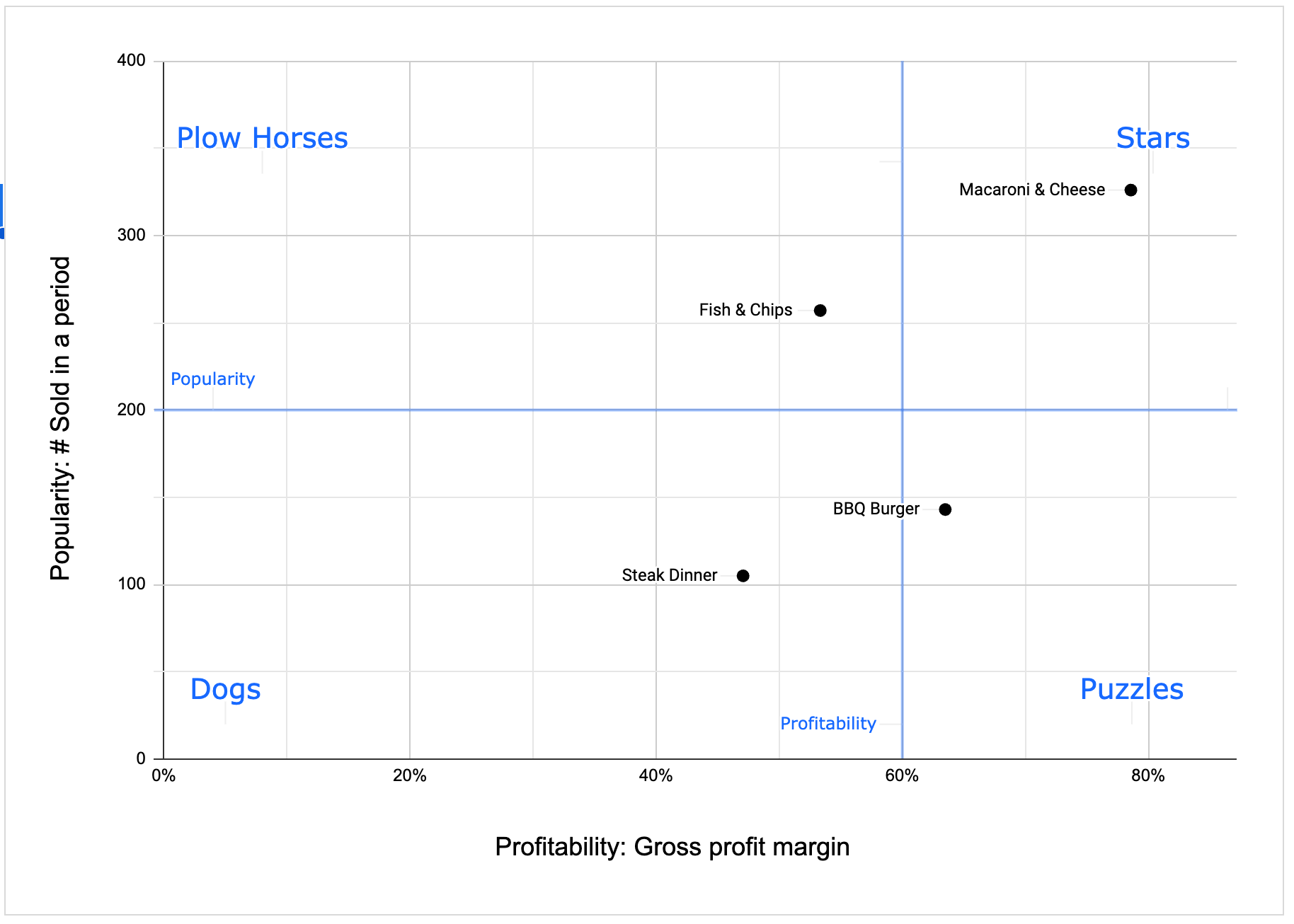
Stars: High profitability. High popularity.
Your stars are what your guests love about your restaurant. If you haven't already, consider developing your restaurant brand around these menu items. Here are some ways to start.
- Put your stars at the top left of each menu section
- Call them out as recommendations among your menu offerings
- Add stars to your online ordering (if they travel well)
- See what guests are pairing with them (PMIX report) and create more stars
Plow horses: High popularity. Low profitability.
Plow horses are liked by your guests, but they may not be bringing in enough profit. You've got two options here. You can try to lower the cost of the dish without changing its popularity. Or you can raise its price. Just don't do both at the same time. Some options are to:
- Reduce the portioning (if guests often don't finish it)
- Find a vendor that offers the ingredients at a lower cost
- Modify the ingredients so the recipe cost is cheaper
- Raise the price to reach your target gross profit margin
Puzzles: High profitability. Low popularity.
Puzzles can be confusing. They're designed for profit but people don't order them. Look at where your puzzles sit in the matrix. If they're close to your popularity threshold, they could be worth saving. If not, maybe it's time to get rid of them. Consider these actions.
- Compare your best puzzles to your stars and see how to improve them
- Create deals around your puzzles to get more people to try them
- Remove puzzles that have an extended period of little to no sales
Dogs: Low profitability. Low popularity.
No profit or sales. From your guests' eyes, dogs are your worst menu items. If a dog happens to fall near where your profitability and popularity thresholds meet, then you may be able to revive it. Otherwise, these menu items are the first places you should start when downsizing your menu.
- Follow the puzzle recommendations to increase popularity
- Follow the plow horse recommendations to increase profitability
- Remove from your menu if the item continues to underperform
Reporting has helped us track our dessert sales. We were able to see that by using a dessert cart vs a dessert menu, we were able to increase our dessert sales by 18%, about $25,000 in sales.
–Dominic Vicari, Joe Muer
How to design your menu for profit
Once you've analyzed and modified your recipes and pricing (perhaps you've even removed a few or several items), it's time to utilize restaurant menu design to make your menu stand out. Let's explore how to do that.
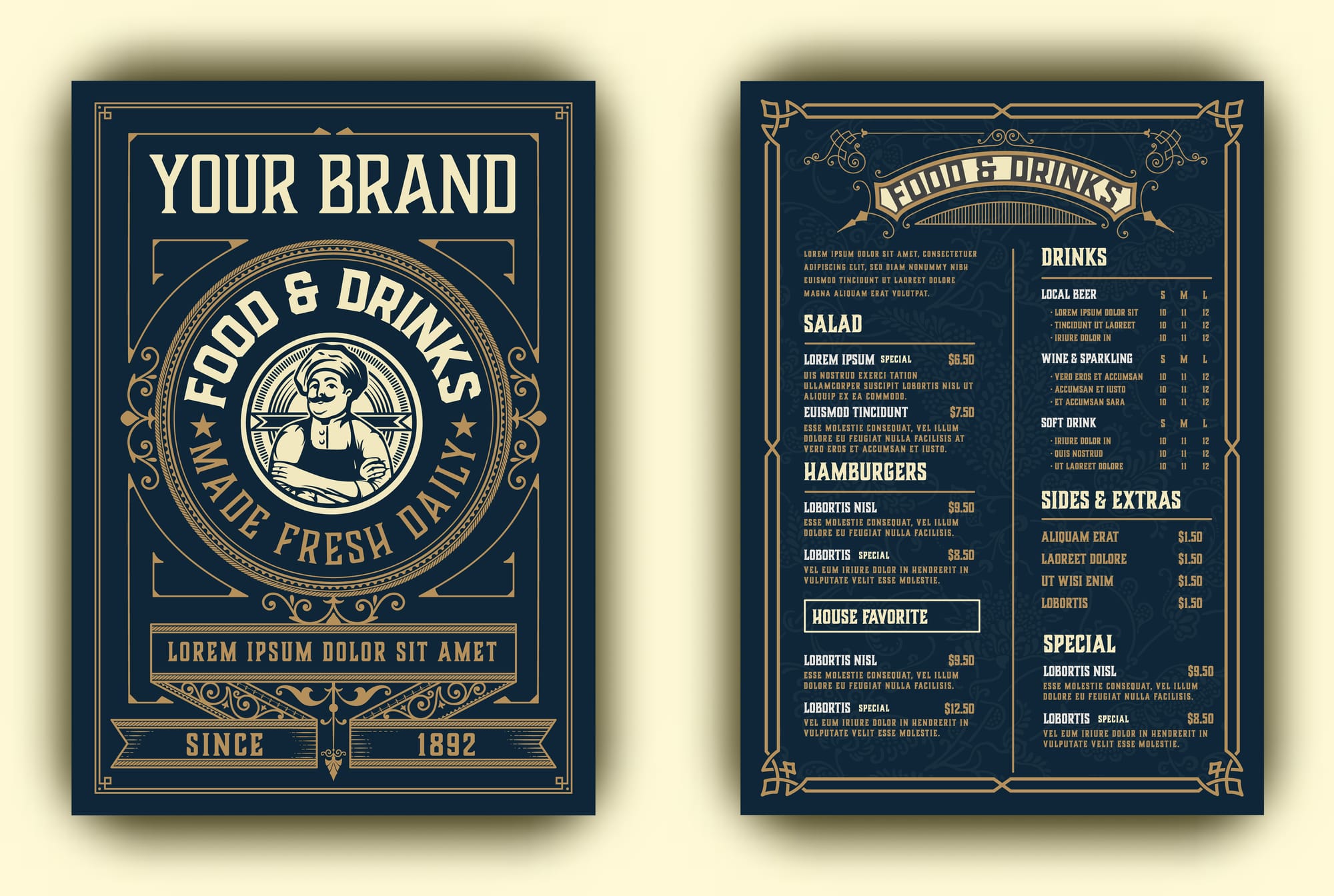
Establish your brand
Your brand represents how guests feel when they interact with your restaurant. If you haven't already, work with a restaurant menu design expert to create a logo system, brand color palette, and unique font suite.
A good designer can also develop your menu layout with wayfinding so guests can see your stars and easily navigate your menu. Or, to avoid printing restaurant menus altogether, consider moving your entire menu online and giving guests access to it on their phones through QR codes.
Tap into menu psychology
When considering your menu design, you can utilize a few techniques to make your food more enticing and your prices more subtle. Let's explore some of these concepts
Prices
Put prices after your menu description and remove currency signs to deemphasize pricing. Also, consider having prices end in .00, .25, .50. or .75 instead of .99 or .95 to avoid looking salesy. And for a more upscale feel, use flat prices without cents.
Design
Left-align your text for stability. Avoid using a script font in your descriptions, favoring an easy-to-read serif or san-serif font. Make your menu items considerably more prominent than your descriptions, keeping in mind guests don't want to read every word but would instead scan headers and only read what sounds good.
Text
Keep your descriptions short. Cut out unnecessary words to show you value your guests' time. Avoid overusing superlatives and excessive adjectives. Tell guests how items are prepared—grilled, marinated, sauteed, oven-roasted. Be more descriptive with higher-priced items, like entrees, and leave descriptions off of simple items, like beverages.
Update your website
Your website should be the first place your guests go online when they want to learn about your restaurant, view hours of operation, or order takeout and delivery. That's why it must be up-to-date, branded, and connected to your online menu. If your website needs a refresh, consider using a website service that can help you get it on brand and make it easy to navigate.
Plug in online ordering
As mentioned, online ordering is critical to making the most profit with your menu. It enables customers to order takeout and delivery from anywhere outside your restaurant and allows guests to access your menu in-house through QR codes at their tables or near your entrance.
When your online ordering integrates seamlessly with your restaurant POS system, guests can easily order and pay from your newly-optimized menu right from their phones with just a few taps. Even if you already have online ordering, you can use your POS's data analytics tools to improve its profitability.
Menu engineering is profit engineering
Although inflation and food costs are uncontrollable, your restaurant doesn't have to be. With precise menu engineering, you can know what items are performing the best and create the most profitable restaurant menu possible.
As trends change, successful restaurants are using menu engineering to stay current with customer preferences and adapt their menu ingredients. When inventory management software integrates with a modern POS system, tracking these trends becomes automatic, making driving more profit easier.
